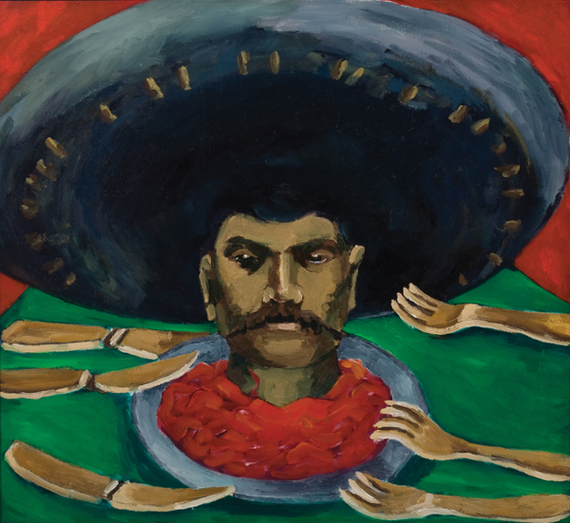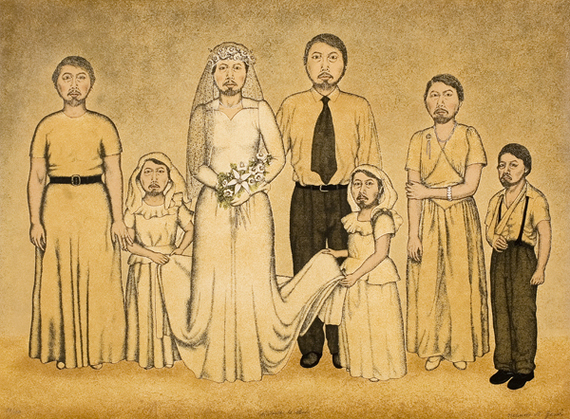
NeoMexicanism, curated by Edward Hayes Jr., Assistant Curator at the Museum of Latin American Art, is a bold show. It's also a problematic one. While the work is interesting enough, it's hard to embrace the exhibition as a whole with the same enthusiasm as with other recent MOLAA offerings.
The exhibition focuses on work from the 80s to the present day. Artists include Monica Castillo, Julio Galan, and Nahum B. Zenil. For historical context, it also includes work by David Alfaro Siqueriros and Francisco Zuniga. Most of the work comes from MOLAA's own collection. Some comes from the collection of W. Nicholas Ingram. Academically, it's a tidy little show, with an installation that isolates key work seen from strategic vantage points.
The show requires two sets of evaluation. One for the work on display, another for the attempt to justify the work. At another time, in another place, with another premise, the work would stand up to the show's analysis. Not here, not now.

Mónica Castillo Plato de Zapata / Zapata's Dish, 1987. Oil on canvas. Nicholas Ingram Collection. Photo by Blue Fire, courtesy of Teresa Eckmann.
Individually, a lot of the work is rapturous. Javier de la Garza's oil on canvas Estructuras/Structures, for instance, quantifies organic spiritual experience with a geometric grid. Nahum Zenil's Poem II - En su llama mortal la luz te envuelve poetically illustrates one of Pablo Neruda's love poems. The work of two artists shows a country in crisis. Franco E. Mendez Calvillo's 4-piece collage series, Los meses negros de Mexico/Black Months of Mexico and Ruben Ortiz-Torres' five-part photograph series Retratos de vida y muerte/Portraits of life and death.
The work is framed as a reaction against Mexicanism, Mexican figurative art of the Thirties. Artists like Diego Rivera, David Alfaro Siqueiros, and Francisco Zuniga graphically consolidated the new identity of post-Revolution Mexican society. The movement eschewed the influence of European Modernism. (It must be admitted, though, that the Cubist work that the young Rivera created in Paris is spectacular.) Seeking to create an art that the country could call its own, Mexicanism harvested indigenous traditions, elevated peasants to the same status as national heroes, and created some of the best work of the 20th century. Much of this work has been shown at MOLAA over the years. It's also been showcased in former director Gregorio Luke's wildly popular outside slide lectures.
Despite its celebration of permanent collection work, its interesting individual pieces, and its effective installation, however, the show raises more problems than it solves.

Nauhm B. Zenil, Retrato de boda, 1992 Lithograph. Robert Gumbiner Foundation. Photo courtesy of MOLAA.
As the didactic text documents, Mexican culture in the late 80s/early 90s went through an identity crisis. One reason was a distrust of politicians. Another was a lack of confidence in the economy. Art became two-edged. Like a Trojan Horse, it would engage Mexicanism styles, subjects, and themes at the same time that it would undercut and critique the society that it reflected. Nothing, including sexual preference and religion, was sacred. The displayed work's not overtly subversive. If you know to look for it, though, you can find examples of this subversion in each piece on display. That's the problem. It's not apparent in the work.
The premise, then, doesn't explain the work. Though the work is interesting enough, the show comes off as an academic exercise. That much you can see through the repeated use of the word "deconstruct." Whereas Mexicanism art was legible, of, by, and for the people, one wonders if present-day peasants would understand the Neo part of the argument, much less the word deconstruct. Perhaps it would be more productive to say that the work seeks to recalibrate or redress the Mexicanism identity instead of simply and conveniently deconstructing it.
Perhaps a better title for the show would be UnMexicanism. Neo suggests continuity. This exhibition doesn't provide that. Does this show mean to suggest that Mexico's 20th century heritage has lost its relevance? Icons never lose their relevance, reactions to them do, especially when society and the art that it reflects resort to irony and dark humor.
Museum hours are 11AM - 5PM, Wednesday, Thursday, Saturday and Sunday and 11AM - 9PM, Friday. The show runs until September 28. Admission is $9, general admission and $6, students and seniors. Admission is free each Sunday and the fourth Friday of each month from 5 - 9pm. The Museum is located at 628 Alamitos Avenue, Long Beach, CA 90802. For more information, call (562) 437-1689 or visit www.molaa.org.
